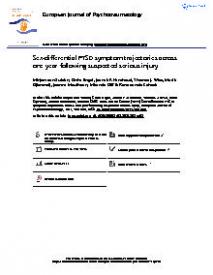Sex-differential PTSD symptom trajectories across one year following suspected serious injury
Background: Recent years have shown an increased application of prospective trajectoryoriented approaches to posttraumatic stress disorder (PTSD). Although women are generally considered at increased PTSD risk, sex and gender differences in PTSD symptom trajectories have not yet been extensively studied.
Objective: To perform an in-depth investigation of differences in PTSD symptom trajectories across one-year post-trauma between men and women, by interpreting the general trends of trajectories observed in sex-disaggregated samples, and comparing within-trajectory symptom course and prevalence rates.
Method: We included N = 554 participants (62.5% men, 37.5% women) from a multi-centre prospective cohort of emergency department patients with suspected severe injury. PTSD symptom severity was assessed at 1, 3, 6, and 12 months post-trauma, using the Clinician Administered PTSD Scale for DSM-IV. Latent growth mixture modelling on longitudinal PTSD symptoms was performed within the sex-disaggregated and whole samples. Bayesian modelling with informative priors was applied for reliable model estimation, considering the imbalanced prevalence of the expected latent trajectories.
Results: In terms of general trends, the same trajectories were observed for men and women, i.e. resilient, recovery, chronic symptoms and delayed onset. Within-trajectory symptom courses were largely comparable, but resilient women had higher symptoms than resilient men. Sex differences in prevalence rates were observed for the recovery (higher in women) and delayed onset (higher in men) trajectories. Model fit for the sex-disaggregated samples was better than for the whole sample, indicating preferred application of sex-disaggregation. Analyses within the whole sample led to biased estimates of overall and sex-specific trajectory prevalence rates.
Conclusions: Sex-disaggregated trajectory analyses revealed limited sex differences in PTSD symptom trajectories within one-year post-trauma in terms of general trends, courses and prevalence rates. The observed biased trajectory prevalence rates in the whole sample emphasize the necessity to apply appropriate statistical techniques when conducting sex-sensitive research.
HIGHLIGHTS
• We investigated sex differences in PTSD symptom trajectories over one-year post-trauma.
• We observed modest differences.
• Symptom courses were mostly similar.
• Yet, the recovering trajectory was more prevalent in women, while the delayed onset trajectory was more prevalent in men.
In: European Journal of Psychotraumatology ; ISSN: 2000-8066 | 13 | 1 | februari | 2031593
https://doi.org/10.1080/20008198.2022.2031593


